Now celebrating its first anniversary, MBmore (岩筆模) is one of the few spaces dedicated to selling work by Taiwanese print artists.
“MBmore gives artists a platform and people who aren’t familiar with printmaking a chance to learn more about it,” manager Su Yu-ting (蘇鈺婷) told the Taipei Times.
Su’s own highly detailed etchings are sold in the store, which is located in Zhongshan Metro Mall (中山地下街) next to an exhibition space run by the Museum of Contemporary Art (MOCA, 台北當代藝術館). The address is Zhongshan Metro Mall B39 (台北捷運中山地下街B39), near exit R9 between Zhongshan (中山) and Shuanglian (雙連) MRT stations.
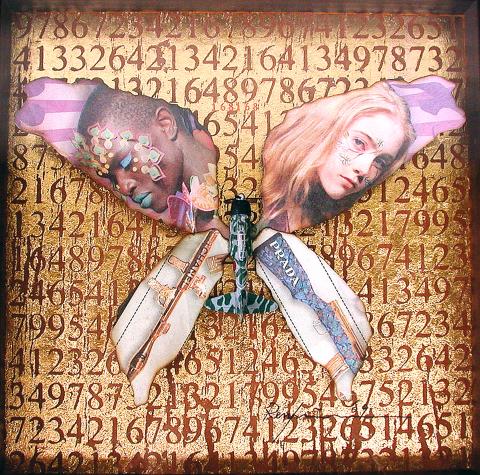
Photo Courtesy of Lin Ren-hsin
MBmore carries work by more than 40 individual artists and studios. Printmaking techniques represented include aquatint, woodcuts, silk-screening and letterpress. Art styles and subject matter are just as diverse. Chen Hua-jun’s (陳華俊) darkly humorous etchings are inspired by manga, while the lush and colorful images created by Huang Chun-yuan (黃椿元) use motifs from Japanese and Taiwanese culture and art.
Other items for sale include greeting cards, silk-screened canvas totes and T-shirts by MuSe Handmade and In Blooom (印花樂), and individual lead type from Ri Xing Typography (日星鑄字行).
Founder Lin Ren-hsin (林仁信) wants to cultivate an audience for his fellow print artists. Lin, who has exhibited in France, Japan and the US, says printmaking is underappreciated in Taiwan, where it is often viewed as just a way to make inexpensive reproductions of work originally created in another medium.
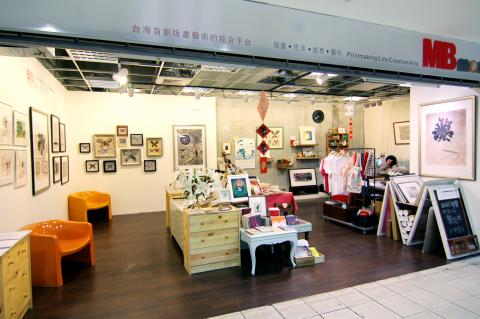
Photo: Catherine Shu, Taipei Times
While many people are familiar with the woodblock prints of Taiwanese-Japanese singer Judy Ongg (翁倩玉) and, to a lesser extent, Taiwanese artist Liao Shiou-ping (廖修平), it is challenging for younger print artists to find an audience.
“When people think of art, they think of watercolors, ink paintings, oil paintings, but they are unfamiliar with printmaking, even though prints are more accessible. But that means galleries don’t focus on prints because they are less expensive and people associate cost with value,” Lin says. (Numbered and signed limited edition prints in MBmore range in price from NT$300 to NT$80,000, with many costing NT$2,000 to NT$5,000.)
Lin, who teaches printmaking classes at Taipei National University of the Arts (TNUA, 國立臺北藝術大學), keeps a magnifying glass on hand to give visitors a closer look at the delicate details and fine lines of etched pieces or the different textures of papers and inks.
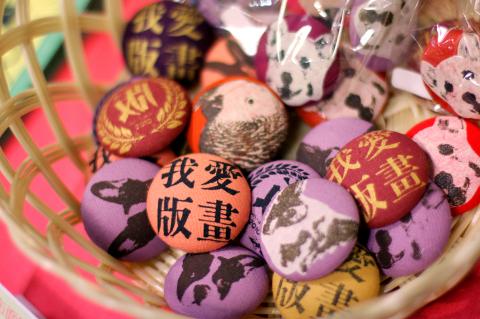
Photo: Catherine Shu, Taipei Times
“A print has an entire universe you can enter and there isn’t just one way of looking at it,” he says.
Like Lin and Su, all employees of MBmore are experienced print artists. The store has a reading area and a shelf of books in Chinese and English about printmaking. Classes taught at the store range from simple greeting card workshops to month-long advanced courses.
“We want to encourage people to stop by whenever they have questions about materials or techniques,” Lin says.
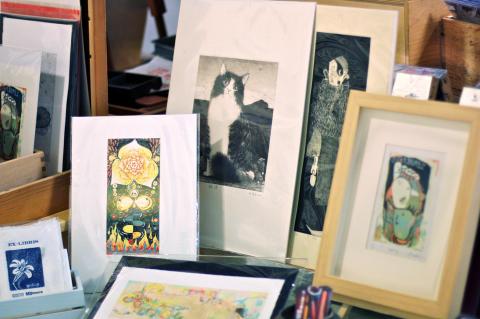
Photo: Catherine Shu, Taipei Times
MBmore also hosts exhibitions: The current show features Lin’s Multiply X Butterfly Effect series of mixed media print collages that explore Taiwan’s history and relationship with the rest of the world. Next on the calendar is an exhibit by artists and students from the Affiliated Senior High School of National Taiwan Normal University (師大附中).
“If you want something to hang in your home, you don’t have to buy a poster from Ikea that will fade in a couple years,” Lin says. “For the same amount of money, you can enjoy an original piece of art.”
TEL: (02) 2523-7737
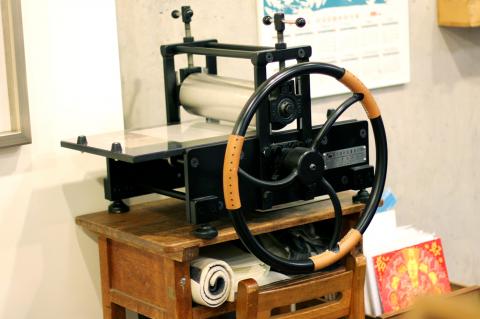
Photo: Catherine Shu, Taipei Times
On the Net: mbmore1024.blogspot.com
Read on for an introduction to a few of the more than 40 artists whose prints are sold by MBmore...
Su Yu-ting (蘇鈺婷)
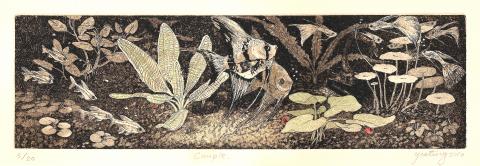
Photo Courtesy of Su Yu-ting
Su’s romantic prints are filled with images of nature. Done in silvery black-and-white, Couple was inspired by Su’s fish tank and features a pair of angelfish surrounded by a forest of aquatic plants. Viewed up close, you can see tiny details in the scales and curling fins of the fish, as well as the veins of the plants and sparkling bubbles floating in the water.
picasaweb.google.com/musehandmade
Chen Hua-jun (陳華俊)
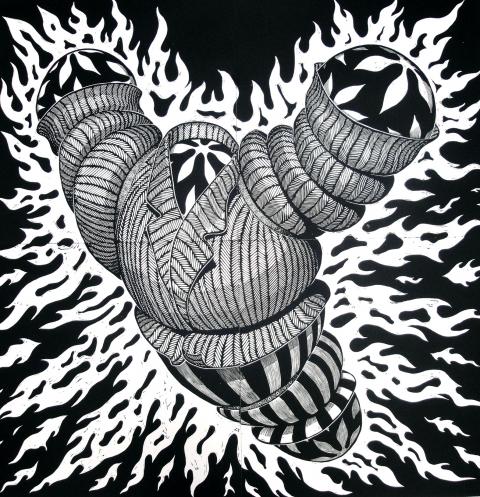
Photo Courtesy of Chen Hua-jun
Chen’s darkly humorous prints include one series that re-imagines popular manga characters like Astroboy as decrepit old men. Another called Fly for Love (迎向愛) turns penises into superhero-like characters sporting tweedy jackets or tight underpants.
www.wretch.cc/blog/chj2606
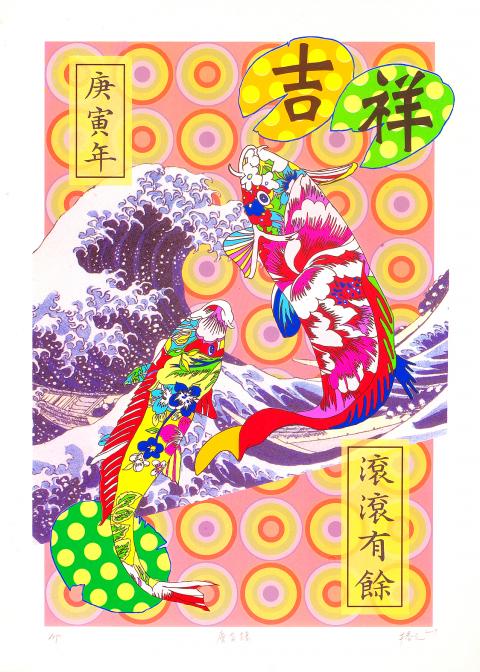
Photo Courtesy of Huang Chun-yuan
Huang Chun-yuan (黃椿元)
Huang is the founder of Tsubaki Print Studio (椿版畫工作室), which teaches workshops and creates commissioned artwork. Huang’s vividly colored artwork incorporates elements from Japanese and Taiwanese culture, including motifs from Taiwan floral cloth, the tiger on the short-lived 1895 Taiwan Republic’s flag and the famous woodblock print The Great Wave off Kanagawa by Japanese artist Hokusai.
www.wretch.cc/blog/tsubakiprint
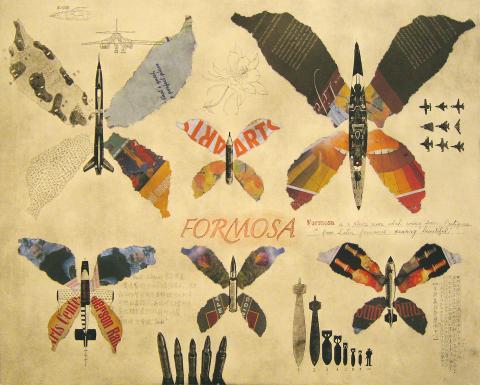
Photo Courtesy of Lin Ren-hsin
Lin Ren-hsin (林仁信)
Lin created the first piece in his Multiply X Butterfly Effect print series in 2007 shortly after returning from the US, where he took part in an exchange program at Anderson Ranch Art Center in Colorado. The series explores Taiwan’s political and cultural relationship with the rest of the world. Three-dimensional butterfly collages with paper wings shaped like Taiwan pay homage to this country’s past as one of the biggest butterfly specimen exporters in the world.
renhsin.blogspot.com

A vaccine to fight dementia? It turns out there may already be one — shots that prevent painful shingles also appear to protect aging brains. A new study found shingles vaccination cut older adults’ risk of developing dementia over the next seven years by 20 percent. The research, published Wednesday in the journal Nature, is part of growing understanding about how many factors influence brain health as we age — and what we can do about it. “It’s a very robust finding,” said lead researcher Pascal Geldsetzer of Stanford University. And “women seem to benefit more,” important as they’re at higher risk of

March 31 to April 6 On May 13, 1950, National Taiwan University Hospital otolaryngologist Su You-peng (蘇友鵬) was summoned to the director’s office. He thought someone had complained about him practicing the violin at night, but when he entered the room, he knew something was terribly wrong. He saw several burly men who appeared to be government secret agents, and three other resident doctors: internist Hsu Chiang (許強), dermatologist Hu Pao-chen (胡寶珍) and ophthalmologist Hu Hsin-lin (胡鑫麟). They were handcuffed, herded onto two jeeps and taken to the Secrecy Bureau (保密局) for questioning. Su was still in his doctor’s robes at

Last week the Democratic Progressive Party (DPP) said that the budget cuts voted for by the China-aligned parties in the legislature, are intended to force the DPP to hike electricity rates. The public would then blame it for the rate hike. It’s fairly clear that the first part of that is correct. Slashing the budget of state-run Taiwan Power Co (Taipower, 台電) is a move intended to cause discontent with the DPP when electricity rates go up. Taipower’s debt, NT$422.9 billion (US$12.78 billion), is one of the numerous permanent crises created by the nation’s construction-industrial state and the developmentalist mentality it

Experts say that the devastating earthquake in Myanmar on Friday was likely the strongest to hit the country in decades, with disaster modeling suggesting thousands could be dead. Automatic assessments from the US Geological Survey (USGS) said the shallow 7.7-magnitude quake northwest of the central Myanmar city of Sagaing triggered a red alert for shaking-related fatalities and economic losses. “High casualties and extensive damage are probable and the disaster is likely widespread,” it said, locating the epicentre near the central Myanmar city of Mandalay, home to more than a million people. Myanmar’s ruling junta said on Saturday morning that the number killed had